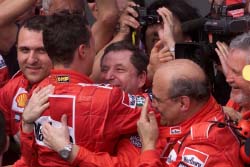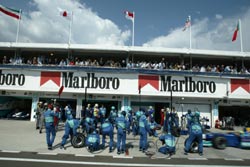
Perhaps so. For example, a top team such as Ferrari has 500 people working for them in order to make sure there are two immaculately prepared race cars on the grid every fortnight. At the other end of the spectrum there is a team like Minardi, who currently employs just over 100 people.
However at each race weekend, a race team uses only a small percentage of this, approximately forty people, to look after three racing cars. Of the forty, ten are involved on the administrative side of the team, and so the rest are the people who are directly involved in taking care of the cars.
First of all, there are two race cars plus one other car known as a spare or T-car. Then there are seven mechanics working on each car. The No. 1 Mechanic is responsible for the front end of a car. He takes care of the front axle, front dampers, front brakes etc.
The No. 2 Mechanic is in charge of the gearbox and its hydraulic systems. The
No. 3 Mechanic looks after all the mechanical parts of the rear end. The
Composites Mechanic oversees all the bodywork on the car. Then there is a
mechanic entirely in charge of the engine, and another solely looking after the
tyres. Finally a mechanic known as the "wire man" looks after all the electronic
sensors.

All these mechanics are under the supervision of one more mechanic. This person literally supervises just one car, so there are two of them in a team, and they eventually report up to one Chief Mechanic.
Then there are the engineers. What is the difference? Basically, engineers work out what needs to be done to each car (from their respective telemetry) to improve its performance out on track, their computations are then fed back to the mechanics in the form of the exact modifications that need to be made.
There are at least four engineers per car. There is the Race Engineer who is the only point of contact with a driver and therefore he is the one who listens to the driver's feedback. A well-known example of this is Jacques Villeneuve's race engineer Jock Clear, who can often be seen in deep consultation with his driver.
The Engine Engineer is, as the name suggests, in charge of the engine unit. There is a Data Engineer, who can most often be found hiding behind the screens at the back of the garage constantly monitoring data screens.
A Systems Engineer looks after all the systems on the chassis such as the gearbox, traction control, power steering, differential etc. Then there is at least one Software Engineer (two if the team is big) for both cars.
Bigger teams such as Ferrari and McLaren normally equip themselves with several data and systems specialists. Obviously if there is an aerodynamic test, aero engineers also get shipped out to oversee the programme.
There is only one Chief Engineer, who is in charge of both cars. It is not necessary for a Technical Director to be on site as the chief engineer has the power to acknowledge any change. However some feel obliged to be in contact with the every day progress of the team and others spend more time concentrating on delegating the development programme.
For example, Adrian Newey of McLaren is often seen at circuits while Mike Gascoyne of Renault is present less often - it all comes down to the best management style for the outfit.
In fact, a team can survive without a Technical Director entirely. A good example of this being Jaguar, who have not named any member of their company as Technical Director, but whose car has recently made a step forward in terms of performance under the directorship of Guenther Steiner, who is the Managing Director of the team.
A change made to the car is executed through a series of simple steps. For example, if a new part is added a driver will be asked to run a few laps to get the feel of this component. He will then talk to his Race Engineer about it. Any change that is then required is passed on to the Chief Mechanic, who directs the appropriate mechanic to modify the machine as requested.
Once the change has been made, it will be reported back to the Race Engineer, who jots down any decisions taken on his report. The mechanics on the separate cars are in a form of competition, although not in direct conflict, as they all want their driver to emerge on top! The only time they all work together is during a pit stop. This is seen as positive, though, as it spurs both drivers' teams onto the ultimate success.
The Team Manager and Chief Mechanic are in charge of deciding who is to go where on the car when servicing it during a pit stop, depending on the suitability of each individual. A big stocky guy will be chosen for the rear jack mechanic or fuel rig operator, whereas a quite agile athletic guy will be the front jack man. The front jack man has to have quick reflex actions - for obvious reasons!
So, how do you go about achieving your dream of working in Formula One? The engineers have graduated with an engineering-related university degree of some sort, which they follow up with motor sport experience as they try to break into Formula One.
Mechanics often have worked their way up from lower formulae. They serve an apprenticeship in these lower categories and, even when they reach Formula One, their work normally starts at the factories before graduating to the test team and finally the race team.
Once in the team, as with all jobs, the flair and aptitude demonstrated by each individual as well as their commitment propels them up the ladder of responsibility.
So, next time you are watching a slick pit stop give Michael Schumacher the jump over one of his rivals on television, or looking at drivers celebrating their latest success with champagne on the podium you will have some idea of just how many people have contributed behind the scenes.